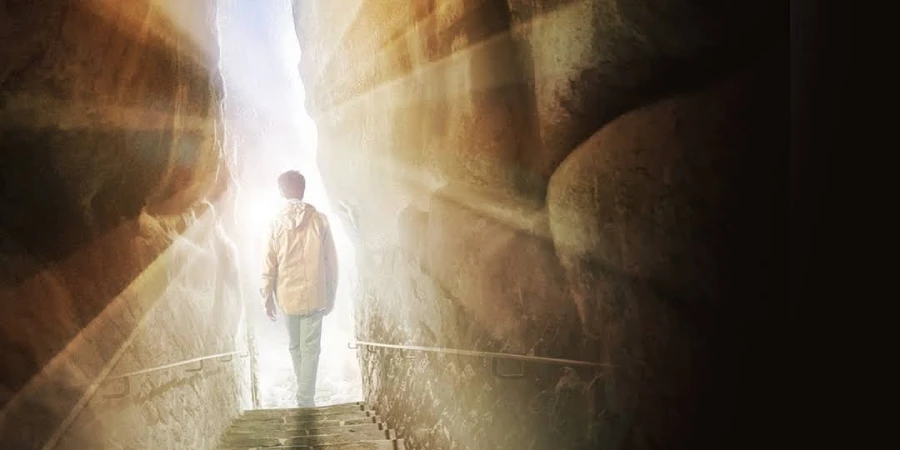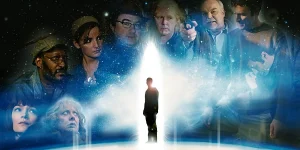The Man from Earth: Holocene is the 2017 sequel to the 2007 cult classic The Man from Earth. Directed by Richard Schenkman and co-written by Jerome Bixby’s son, Emerson Bixby, the film continues the philosophical and existential themes of the original—this time expanding the narrative scope and introducing a younger generation of truth-seekers into the mix.
Table of Contents
ToggleDetailed Summary
A New Chapter for John Oldman
Ten years have passed since the events of the first film. John Oldman (David Lee Smith), the mysterious 14,000-year-old man who once revealed his immortality to a roomful of colleagues, is now living under a new identity as a college professor in Northern California. He’s trying to live quietly and avoid attracting attention—but of course, that doesn’t last long.
Students Begin to Uncover the Truth
A group of his students—smart, curious, and digitally savvy—begin to suspect that there’s more to John than meets the eye. Their suspicions are aroused after they discover peculiar inconsistencies in his records, his knowledge that seems impossibly deep and timeless, and the uncanny feeling that he’s hiding something significant. The students, led by Isabel, Art, and Philip, start digging into John’s past.
Through their research, they come across the manuscript from the first film—where John revealed his life story to his friends—which has now surfaced on the internet as a kind of underground philosophical text.
The Aging Mystery
One of the most intriguing developments is the revelation that John might be aging. He’s begun to notice physical and cognitive changes—aches, slower reflexes, and even memory lapses. This revelation adds a layer of existential dread not only for John, but also for the audience: Is his long journey finally nearing its end?
The Students’ Confrontation
Eventually, the students confront John directly, challenging him on his identity. He denies nothing, yet refuses to openly confirm anything either. But when one student physically attacks John and is effortlessly overpowered, their suspicions are all but confirmed. Isabel is the one who finally pieces it together and gets the quiet admission that John truly is who they think he is: the same immortal being who walked the Earth for thousands of years.
Meanwhile, his academic career is put in jeopardy due to accusations and controversies stirred by his unusual behavior and the students’ relentless probing.
Movie Ending
The final act is subtle but emotionally weighty. John, now uncertain about his longevity and facing the potential reality of death for the first time in thousands of years, decides to leave town quietly, just as he did a decade ago. But this time, he’s not just escaping scrutiny—he’s confronting his own mortality.
Isabel catches him before he departs, pleading for answers and seeking connection. John, clearly moved, admits to her that this might be his last move, as he no longer knows how much time he has left. He expresses regret, fear, and a deep, human sadness—emotions he hasn’t fully experienced in centuries. The film ends with John disappearing once again into anonymity, but this time, not as a man burdened by eternity, but as someone possibly facing the end of his extraordinary life.
It’s a quiet, melancholic close—reflective of the film’s tone. The sequel doesn’t strive for a dramatic finale, but instead chooses to meditate on change, identity, and the inevitability of time, even for someone who has seemingly evaded it.
Are There Post-Credits Scenes?
No, The Man from Earth: Holocene does not contain any post-credits scenes. Once the film ends, it stays ended. No sequel teases, no mid-credits surprises—just a contemplative silence that mirrors the themes of the story.
Type of Movie
This is a philosophical science fiction drama, with a strong emphasis on dialogue, ideas, and existential questions. Like its predecessor, it’s a slow-burn cerebral film meant to provoke thought more than action.
Cast
- David Lee Smith as John Oldman
- Vanessa Williams as Carolyn
- Michael Dorn as Dr. Gil Parker
- Sterling Knight as Philip
- Akemi Look as Isabel
- Carlos Knight as Liko
- Brittany Curran as Tara
- William Katt (cameo) as Art Jenkins
Film Music and Composer
The film’s music was composed by Mark Hinton Stewart. The score is understated and ambient, serving more as an emotional undercurrent than a dramatic element. It supports the film’s intellectual tone, enhancing scenes with minimalism and atmosphere rather than traditional musical cues.
Filming Locations
The Man from Earth: Holocene was primarily filmed in Southern California, especially around forested areas and rural college campuses. The settings were chosen for their subdued, timeless aesthetic, giving the film a sense of placelessness that reflects the transient nature of John’s life. The isolated locations emphasize John’s need for anonymity and distance from civilization.
Awards and Nominations
The film didn’t make waves on the mainstream awards circuit but did receive attention at niche film festivals:
- Nominated for Best Feature at the Boston Sci-Fi Film Festival
- Winner of Best Sci-Fi Feature at the Fantasporto International Fantasy Film Awards
While not a commercial or critical blockbuster, it maintained a strong reputation among fans of cerebral sci-fi.
Behind the Scenes Insights
- The film was partially crowdfunded via Indiegogo, relying on the strong cult following of the original film.
- Director Richard Schenkman originally planned this as part of a trilogy, with a third film called The Man from Earth: Millennium—though it has yet to materialize.
- David Lee Smith returned as John Oldman, anchoring the story with his calm, thoughtful presence.
- The original film became an underground success after it was pirated and shared widely—ironically helping the sequel gain momentum.
Inspirations and References
- The original screenplay was written by Jerome Bixby, a legendary sci-fi writer known for Star Trek and The Twilight Zone.
- The concept plays with philosophical thought experiments like the “immortal man” dilemma, time and consciousness, and theological implications.
- The film alludes to biblical themes and even subtly revisits the controversial idea from the first film: that John may have once been Jesus Christ, though it treads more carefully with that suggestion this time.
Alternate Endings and Deleted Scenes
There are no widely released alternate endings, but early drafts of the script explored more interaction between John and religious institutions or governmental bodies. These were ultimately dropped to maintain the film’s grounded tone.
Some deleted scenes (available via crowdfunding perks) show more classroom interactions and character backstories, but none significantly change the plot.
Book Adaptations and Differences
There is no novel the film is directly based on, but the screenplay of both The Man from Earth and Holocene has been published. The differences mainly lie in tone—the sequel is more accessible and character-driven, while the original felt more like a one-act philosophical play.
Memorable Scenes and Quotes
Key Scenes
- The confrontation between Isabel and John in the forest.
- The students piecing together John’s identity through online sources and surveillance.
- John discussing the concept of aging for the first time in thousands of years.
Iconic Quotes
- “You live long enough, and you learn that nothing is permanent. Not even the things you think are.”
- “I was a caveman. Then a farmer. Then a teacher. Maybe now I’ll finally be… gone.”
- “History forgets. But I remember. I always remember.”
Easter Eggs and Hidden Details
- A printed copy of the manuscript from the first film appears in Isabel’s hands—a nod to how the original story continues to ripple through underground communities.
- A subtle reference to the character Harry (from the original film) appears on a chalkboard during one classroom scene.
- John’s alias, “John Young,” might be a nod to real-life astronaut John Young, adding a layer of irony for a man who predates the moon landing by millennia.
Trivia
- Emerson Bixby, co-writer of Holocene, is the real-life son of Jerome Bixby, making this film a legacy project.
- The original The Man from Earth was written on Jerome’s deathbed and completed posthumously.
- The sequel had a more modest budget than the first film but benefited from more modern filmmaking tools.
Why Watch?
If you’re drawn to slow, intellectual science fiction that emphasizes ideas over action, The Man from Earth: Holocene is worth your time. It’s a quiet, thoughtful film that asks big questions: What does it mean to live forever? What happens when an immortal begins to die? Can truth survive in the digital age? It doesn’t hand you easy answers—but that’s part of the journey.
Director’s Other Movies
- The Man from Earth (2007)
- Abraham Lincoln vs. Zombies (2012)
- The Pompatus of Love (1996)
- Mischief Night (2014)
Recommended Films for Fans
- Coherence (2013)
- Primer (2004)
- Timecrimes (2007)
- Another Earth (2011)
- Donnie Darko (2001)
- The Sunset Limited (2011)













